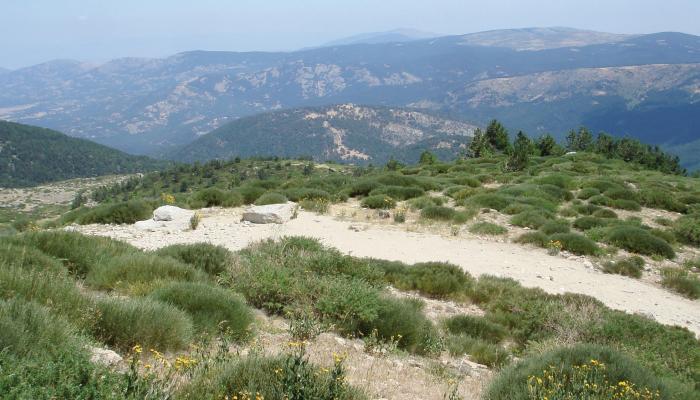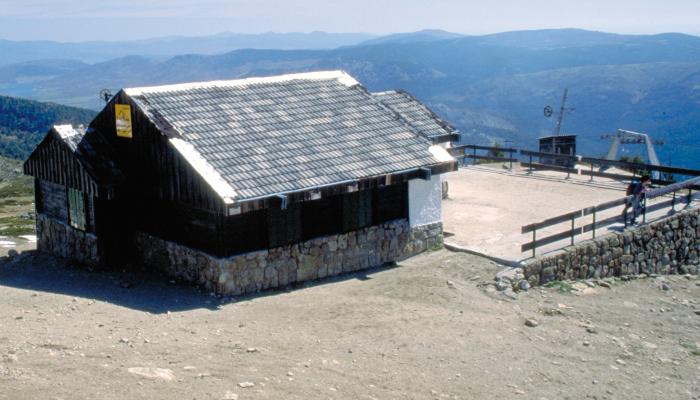

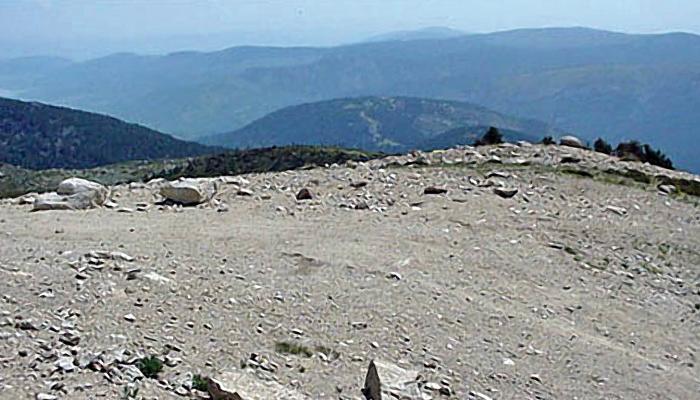
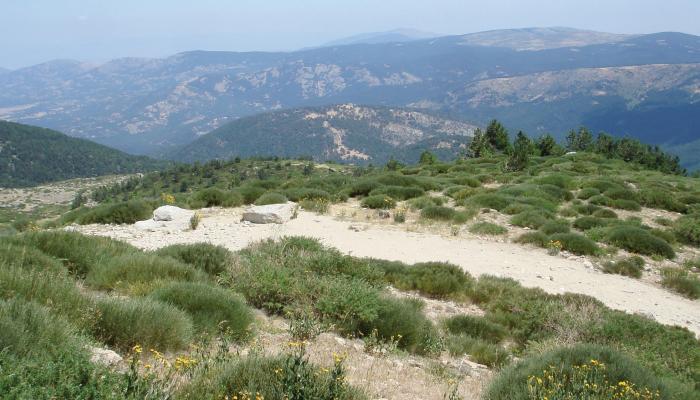
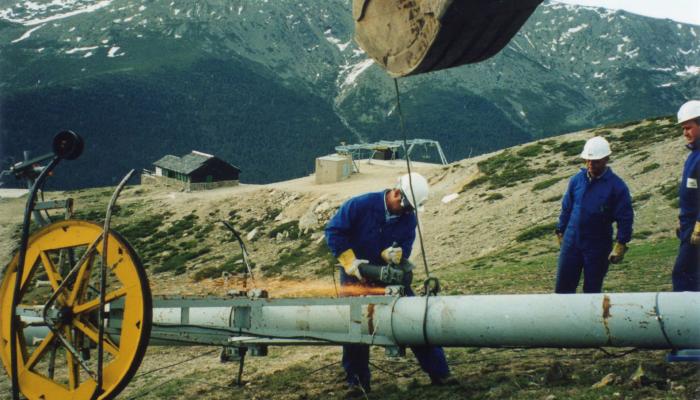
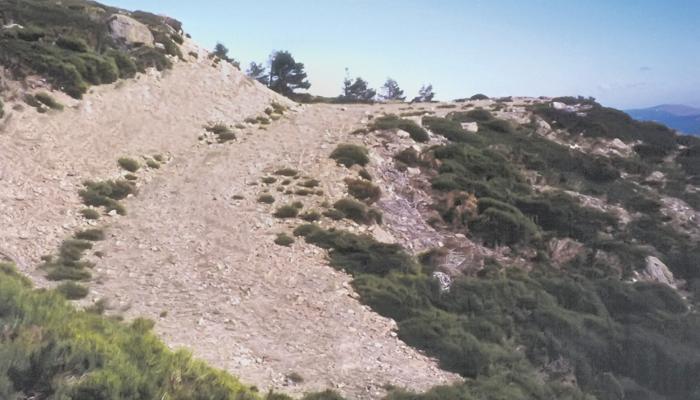
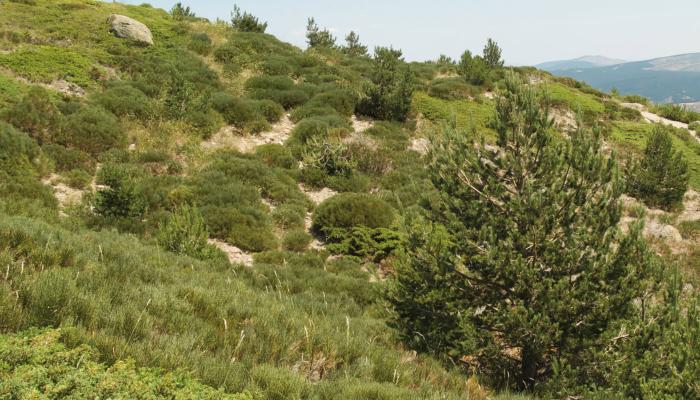
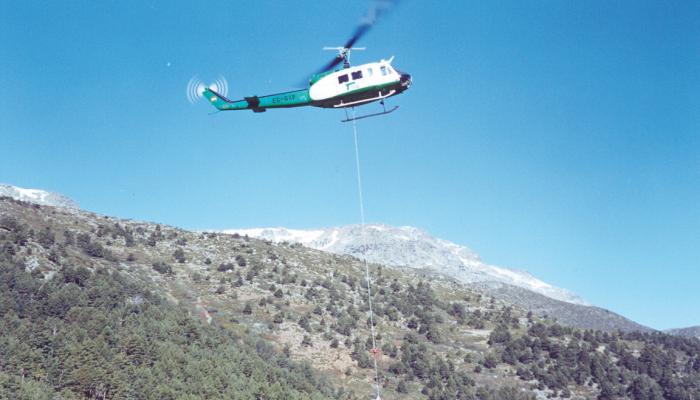
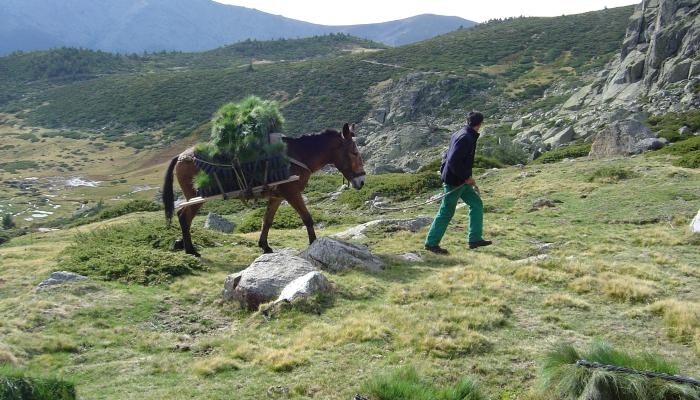
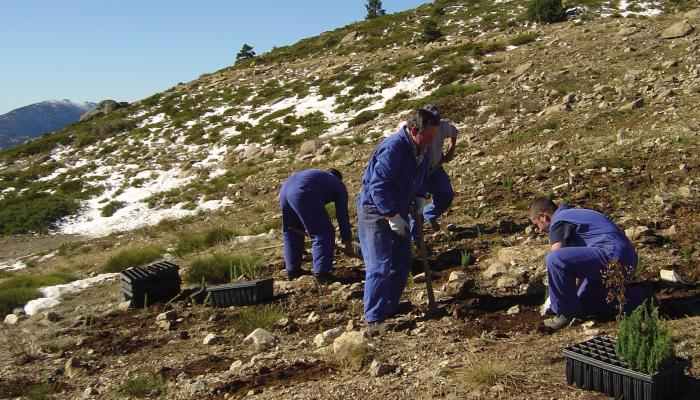
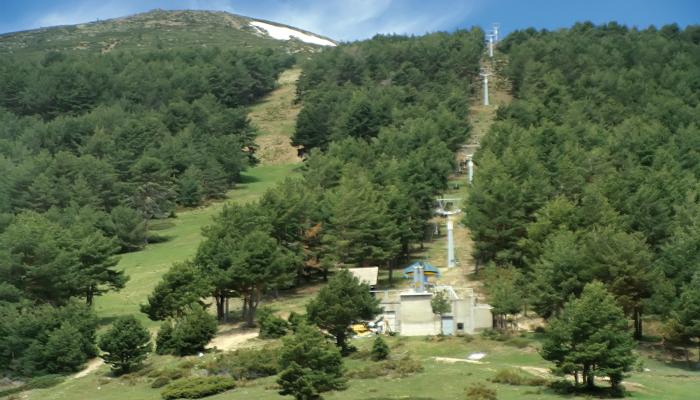
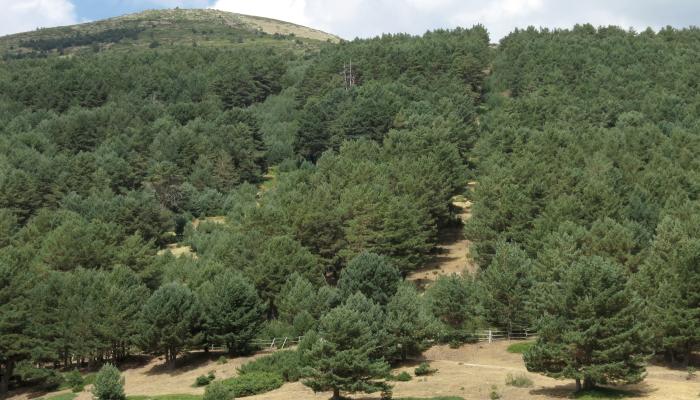
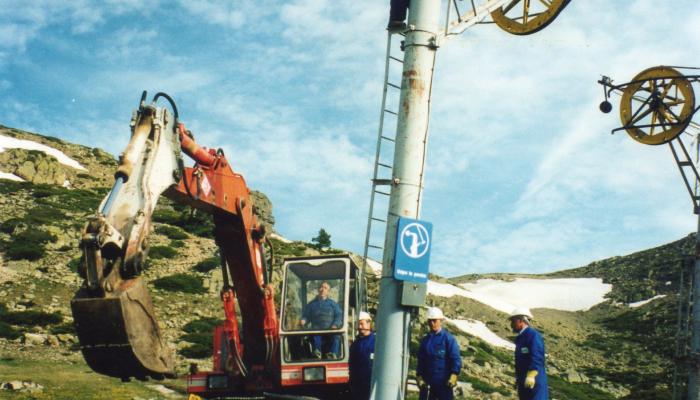
The complete dismantling and ecological restoration of a cross-country ski resort is one of the most noteworthy conservation actions in the Sierra de Guadarrama.
From the 1960s of the last century onwards, a different approach to the use of the mountains appeared, based on large complexes for the mass practice of alpine skiing. The construction in 1969 of the Valcotos ski resort caused the destruction or alteration of valuable ecosystems and unique formations of glacial origin in Peñalara.
The data from the ski resort give an idea of the extent of the transformation undergone: 6 alpine ski slopes were opened with an area of more than 24 hectares; 11 ski lift lines were built totalling about 6 kilometres of route, a hundred bollards or posts for laying them and more than 20 associated constructions. The damage caused included eliminating vegetation, destroying geomorphological elements of glaciation, earthworks and earthworks, erosion and gully formation, landscape impact, etc.
From 1999 onwards, work began to recover the affected ecosystems. Although the most obvious works were carried out between the turn of the century, revegetation, improvement, and monitoring of the actions, continue to be carried out even today.
The Peñalara Natural Park (768 ha) is a protected area with unique natural values, whose objective is the conservation of the most representative and valuable ecosystems of the high mountains. It was declared in 1990 as the first natural area under the Law on Natural Spaces and Wild Flora and Fauna.
On a geological level, it is worth highlighting its excellent geomorphological ensemble of glacial origin, with a well-preserved modelling, which makes up a territory where a great wealth of species, both animal and vegetable, develops. In addition, the presence of numerous formations and sheets of water is an important source of biodiversity and ecological values linked to the presence of aquatic ecosystems.
At the forestry and plant level, it has 8 different systems, made up of:
supra-forest scrubland and high mountain pastures, with woody steppes at high altitude and gravel
Unique mountain and high mountain formations and reliefs
Unique natural systems of glacial and periglacial origin
oak, beech and birch groves
gall oaks and pyrenees
pine, juniper and juniper groves
High mountain wetlands and lagoons
watercourses and riparian forests
In total, there are about 1,680 taxa of vascular plants (with about 343 identified species) and about 200 species of lichens, along with a huge variety of fungi and mushrooms.
At the faunal level, it is also very rich, with numerous endemic species caused by the great geographical isolation to which some of these populations have been subjected.
Up to 10 species of amphibians and 135 species of birds (with regular presence during some time of the year), 61 of mammals (with 6 Iberian endemic species: Iberian hare, Lusitanic vole, Iberian shrew, Iberian mole, Iberian desman and Cabrera vole), 24 species of reptiles (with 3 Iberian endemic species: blind shingles, Iberian skink and green-black lizard), have been located in the Park. 18 species of fish (some of them introduced) and between 15,000 and 20,000 species of invertebrates.
This remarkable specific richness is the result of processes associated with its strong altitudinal gradient and local geomorphological, edaphic and hydrological factors, constituting a true biogeographical island conditioned by a rigorous high mountain climate, with natural connections with surrounding ecosystems and their ecological relationships. However, it was seriously affected as a result of the use and development of the Peñalara massif until the end of the 90s, particularly with the growth and intensive tourist and residential exploitation as a result of the construction and start of operation of the Valcotos ski resort.
In addition to the landscape impact generated, the main alterations detected were, among others, morphological, stratigraphic, runoff and vegetation, so the project faced, for example:
the appearance of more than 30 volumes of buildings scattered throughout the ski area, with ski lifts, motor stations, towers, poles, several kilometers of drag cables, etc.
the construction of water tanks, retaining walls and a large parking lot for vehicles
the transformation of land, with the generation of trenches, earthworks, clearings, embankments and drainage lines
the construction of roads and slopes for vehicle traffic
the elimination of tree and shrub vegetation to recreate the layout of the snow slopes, both in laminar form and in the form of longitudinal gullies, stripping the most superficial part of the mountain soils and dragging their scarce organic matter and seeds
the joint water and wind erosion action that ends up almost completely eliminating the vegetation cover, feeding back the problem of erosion
the modification of the hydrological network, with modification of runoff, creation of drains and dams, and even burying of streams
the accumulation of debris, waste and remains of obsolete buildings or installations
overcrowding and uncontrolled tourist use in high areas of the mountains, with indiscriminate access to fragile corners of high ecological value, with inappropriate activities in a protected area
the degeneration suffered by the high mountain wetlands, in particular by the Laguna Grande de Peñalara, with an unfortunate state of conservation, problems of erosion, eutrophication, accumulation of waste and the presence of char (invasive fish species) with devastating consequences
Along with these situations, as well as due to its own structural characteristics, the Peñalara National Park faced in very unfavorable conditions the new challenges and foreseeable scenarios of global warming, constituting a threat of the first order as a result of the fragility presented by such a sensitive and degraded ecosystem.
Once the territory of the Valcotos ski resort passed to the management of the Natural Park, an ambitious project of environmental restoration of all the altered areas was launched. The Park Management directed the project and the works, helped, at first, by two biologists hired for the first two phases and another two, later for the third and the monitoring today.
The restoration project or plan, in its preliminary phase, follows some previous ideas based on:
- Careful definition of alterations
- Comparison with the 0 moment of the terrain before the installation of the station was carried out
- Comprehensive proposal for corrective measures
- Assessment of induced impacts
- Budget availability
The environmental restoration project was carried out with the following objectives:
- Restore damaged elements of the natural environment: geomorphology, vegetation cover, visual quality of the landscape, etc. with the minimum possible intervention.
- Controlling environmental problems: minimising environmental impacts (erosion, proliferation of trails, conservation measures and maintenance of ecosystems).
- Adapt the facilities and reception areas around the Puerto de los Cotos for visitors to the Peñalara massif (conditioning of accesses and car parks, treatment of discharges, landscape adaptation, installation of self-interpretive elements and signage).
- To organise the uses in a way that is compatible with the conservation of the natural area.
To achieve these objectives, the project was divided into phases, which would make it possible to intervene quickly in the dismantling of all the facilities and restore, just as quickly, the topographical profiles of the terrain to control the impacts and recover the original profiles of the landscape.
Other phases of slower execution would refer to the rest of the planned actions, both those aimed at promoting the regeneration of ecosystems that had been altered during the last 30 years, and obtaining seeds, revegetation and soil improvements without causing any genetic contamination.
This implied that all the actions necessary for dismantling, removing artificial elements, and restitution of the relief had to be carried out with the most appropriate techniques to minimize damage to the best preserved areas. For the regeneration of the affected habitats, it was intended to establish favourable conditions that would help the natural processes of ecological succession without introducing foreign species or genetic material, as has been said, different from that of the populations of the Peñalara Natural Park.
Even today, with the restoration project already completed, the steep slopes, adverse climatic conditions, very intense geomorphological dynamics or the presence of oligotrophic and scarcely buffered aquatic systems, determine that small influences on the environment can have strong environmental impacts.
This fragility means that for this set of systems a relatively small disturbance of environmental conditions generates a response and important change in its physical-chemical and biological conditions, which poses a serious risk to its conservation. And this is particularly sensitive at the level of glacial formations and high mountain lagoons.
In this sense, global warming is causing a modification in the biological cycles of some species, both plant and animal, which in the case of aquatic ecosystems would involve a displacement upstream of some river species, an advancement of the biological cycle to earlier times, and even the disappearance of some others due to the loss of their optimal development characteristics. In addition, atmospheric temperature conditions many other processes, such as the duration of snow cover, water retention in basins, circulating flows and even the development and growth of living beings.
The environmental restoration project undertaken involves the recovery of probably the best representative of the high mountain ecosystems of the Sierra de Guadarrama and one of the oldest protected natural areas in Spain.
The ecological restoration project had to be undertaken in three phases, accompanied by complementary actions. In addition, the works were carried out without any contribution of materials from outside the National Park.
The work undertaken in these phases was:
Phase I.- Dismantling of artificial infrastructures
It was carried out in 1999 and consisted of eliminating artificial infrastructures associated with the practice of alpine skiing, with demolition and removal of pylons, foundation cubes, buildings and ski lift lines. Likewise, a large amount of debris and waste existing in the area, accumulated during the construction and operation of the station, was removed.
An attempt was made to avoid damage to areas adjacent to the work points, for which only heavy machinery was used where access could be gained through the altered areas themselves; in the rest of the areas, manual machinery was used. The evacuation of debris and debris was carried out by helicopters and pack animals to avoid conditioning the runways or opening new ones for the passage of trucks.
The main conditioning factors of these works were the steep slopes, the fragile soils, the climatic conditions, and the high number of visitors while the work was being done.
Phase II.- Topographic restitution
The second phase was carried out between 1999 and 2000, consisting of the restitution of the original relief, the recovery of the water network and the control of erosion. The main objective was the recovery of the physiography of the terrain prior to the construction of the ski resort, for which action was taken in three lines of work:
elimination of esplanades, clearings and slopes, taking care not to destabilise the modified but stable areas
naturalisation of artificial accumulations of stones (cords) on the sides of courts
erosion control in gullies by installing energy-dissipating barriers
As the original arrangement of the glacial deposits could not be restored, work was done to eliminate the impact on the landscape, control the risks of landslides, minimise erosion problems and prepare the soil to favour the natural processes of plant colonisation.
The original layout or the hydrographic basin of some altered streams was also recovered.
Phase III.- Regeneration of the vegetation cover
The third phase of environmental restoration was carried out from the year 2000, although it is still ongoing today. With this action, the regeneration of the vegetation cover has been achieved, stopping the intense erosion processes in the area and favouring the development of vegetation equal to that of the adjacent areas without alteration.
The main tasks developed for this purpose were:
- Collection of woody and herbaceous seeds for direct sowing or for nursery seedling production
- Transplanting vegetative material between different areas in restoration
- fencing of the area of action to promote the growth of the planted or sown species and natural regeneration
- Contribution of organic matter and seeds in the most disturbed areas (about 2 ha) using soil from the cleaning of the firebreaks in the area
- Manual plantings in spring and autumn since 2001
- Support irrigation in the most difficult-to-recover areas
In the regeneration work, the introduction of foreign species and genetic material different from that of the massif's own populations was avoided.
Complementary actions
In addition to these actions, some complementary actions were carried out, such as:
planning and enhancement of trails, rest areas, self-guided itineraries and viewpoints
implementation of information, surveillance, maintenance and visitor control services
Development of basic and applied research to improve scientific knowledge of the park and its surroundings
Development of resource management plans for the economic reactivation of the area
Only recently has the fundamental importance of well-preserved ecosystems for maintaining ecological processes that give rise to ecosystem and environmental services, which are fundamental to society at large, been recognized.
In this case, given the situation of the Peñalara Massif and Paular Valley, what has been done has been of great strategic importance for the supply of water to the city of Madrid, constituting the cistern that provides almost half of the water supplied by the Canal de Isabel II.
The restoration project developed has been—and still is today—a real challenge of comprehensive ecological restoration, acting both to replace the area's natural ecological substrate and to prevent and adapt to climate change.
The actions carried out are intended to replenish, regenerate and articulate a whole series of networks of mutualistic ecosystem interactions based on plant and forest restoration with cementing species native to the area, which define an important fraction of the structure of the local community, and which create stable environmental conditions, attracting other species that disperse fruits and seeds, modulating and stabilizing fundamental ecological processes.
The challenge is to make the territory more flexible and modular to facilitate the spontaneous advancement of the systems, adapted to the territory and the climatic scenario of the landscape and incorporating solutions that facilitate the migration of species for colonization and the reestablishment of the area's own ecosystem, with those local ones that best adapt to the new circumstances of global change.
In this sense, and on the other hand, the Peñalara National Park has been chosen by the Community of Madrid as an observatory of global change since its combination of high mountain areas with a very well-preserved valley head offers the opportunity to simultaneously study different processes of global change.
On the one hand, higher ecosystems are significantly influenced by atmospheric origin, and processes such as air pollution or global warming can be studied without the effect of local influences (nearby sources of pollution, city heat islands, etc.).
On the other hand, the existence of a highly naturalized basin, through which the Lozoya River flows, which is the backbone of the Paular Valley, allows us to observe the environmental changes that are taking place in ecological processes, so that aspects such as the change of use, the cycles of nutrients and pollutants, the hydrological cycle and the biological cycles of the species, they find in this space a true natural laboratory where they can be studied.
The restoration project was promoted by the Community of Madrid and directed by the Director-Conservator of the Peñalara Natural Park, assisted in the process of drafting and subsequent monitoring of the restoration, by biology graduates hired for this purpose. All the restoration work was carried out by personnel from the public company TRAGSA.
It is a unique project of comprehensive ecological restoration in a highly altered and degraded high mountain area, carried out in very difficult conditions.
Indeed, the hostile climatic conditions of the high mountains posed a significant difficulty in carrying out the restoration. During the first phases, drought was alleviated through summer support irrigation, which was very effective, especially in certain areas where, due to their orientation, degradation, or exposure to the wind, they were more prone to water deficit.
Another important aspect of the project was the sourcing of local seeds, as well as their production in the nursery. The project required the use of native material to avoid possible genetic contamination, so in the first place we proceeded to the manual search and collection of seeds from the Natural Park itself and/or its immediate surroundings, tasks that were quite laborious given the large number of plants required and the high number of failed seeds that do not thrive in the nursery.
Secondly, it was necessary to select nurseries with which to collaborate, with capacity, experience and the possibility of testing and testing different techniques, until the mass production of seedlings of some species was optimised.
It was also very useful to progressively adapt the seedlings obtained in nurseries to these harsh conditions, for which, after mass production, they were transferred to controlled areas (acclimatisation nurseries) located at high altitude (Puertos de la Morcuera and Los Cotos) for their adaptation to these climatic conditions and, in some cases, their adaptation to irrigation water, as some of the nurseries were located in areas south of Madrid where they were irrigated with harder water and with a higher salt content.
During the revegetation work, an attempt was also made to create "islands" of different species, sheltering them as much as possible under the shelter of large stones and bushes, seeking more benign environmental micro-conditions in terms of humidity levels, protection against sunstroke, wind, extreme temperatures, etc. This is what is known as nursery plants that facilitate, in addition to their own growth, the germination and subsequent development of seedlings in their most fragile initial stages.
Another interesting aspect of the project is the requirement of a continuous learning process in this regard, since it was a pioneering action and despite the fact that, from the Park Management, as director of the works, an attempt was made to collect information from various official bodies on similar experiences, there was no advice outside the work team.
It should be noted here, due to the importance and effectiveness they had in obtaining the best state of knowledge about the different variables presented by the challenge of undertaking the project, the celebration of a Scientific Conference, organized by the Directorate of the Natural Park, every two years and simultaneously with the years of restoration. The best experts in different disciplines participated in them and provided a lot of light and knowledge to carry out the restoration project.
Without prejudice to the observance of the basic principles of ecological restoration underlying the planning and programming of the works, the precautionary principle and non-action were chosen in cases where the benefit of the action could not be assured.
There was an excellent work team, made up of its own and contracted personnel from the Natural Park, as well as professional experts from a public company. It was also necessary to adapt to the hostile conditions of the area and to the difficulty and constant caution in the execution of the works in a territory of high ecological value and high fragility.
Since the dismantling began, it is evident that the landscape of the old station has evolved favourably towards an increase in vegetation cover. Thus, for example, only in the surroundings of the Laguna Grande, in the nucleus of Peñalara, a revegetation of 94% has been achieved when before it had almost completely disappeared. The same has happened with the most erosive areas treated and with the streets of the old ski lifts.
The objective of the revegetation tasks was to promote the development of plant communities that inhabited the different areas before the construction of the station, which were carried out in altered specific areas (approximately 20% of the total area), so that the processes of regeneration and recovery of the vegetation cover were predominantly spontaneous. In addition, the process was positively favoured by the previous work of relief restoration, erosion control and exclusion of livestock by means of enclosures.
The increase in vegetation cover has been, in general, very important, recovering approximately 70% of the altered area, which in 1999 was covered by a light xerophilous grassland or bare soil. In areas such as the old ski slopes, the recovery has been spectacular, with an increase in coverage of around 85%.
However, in more exposed, stony and/or higher altitude areas, only an increase of less than 10% in coverage was achieved, although it should be noted that in some high mountain areas it is never possible to achieve wide coverage due to soil and/or climatological conditions.
Given the lack of previous experience, a trial-and-error method was followed in the treatment areas, allowing the learning of new effective techniques, with changes both in the planting season (better in autumn after the rains and before frost and snow), and in the arrangement of some species such as the deer, in grouped patches.
Herbaceous species characteristic of the different communities in the environment was used, which was very successful. Some grasses such as Avenella flexuosa, Festuca curvifolia and Nardus stricta showed high survival values, a significant increase in size, production of reproductive structures and production of viable seeds, effectively contributing to the coating thanks to their creeping growth, forming ground covers and increasing their fertility, facilitating the germination and survival of seedlings of other species.
The use of high mountain scrub species, such as mountain broom (Cytisus oromediterraneus), cambroño (Adenocarpus hispanicus) or creeping juniper (Juniperus communis subsp. alpina have also provided very acceptable results. They are very resistant species and adapted to the environment, and the different low and high areas.
The junipers that gave the best results were those with 2-3 saps. The larger ones have suffered much more during the winter, causing massive deaths due to frost, although there were also cases of apparent deaths, which with the arrival of spring produced new outbreaks. In any case, juniper has shown slow growth, characteristic of a species typical of the maturity of plant communities.
Some species such as the black willow (Salix atrocinerea) planted with root balls had no problem rooting, but specimens planted with cuttings gave poor results by keeping the soil temperature below that necessary to allow them to emit roots for too long.
The use of large rocks or bushes as shelter for the new specimens planted has been very effective, as well as the support irrigation during the summer in the early stages.
One of the most successful experiences has been the use of soil from the maintenance work of firebreaks in the area, which has also allowed the contribution of propagules and seeds of pioneering herbaceous plants in areas with very adverse conditions (soil or climatological) in which revegetation was failing.
In general, the restoration work has had important consequences in addition to the landscape ones, gradually restoring the ecological functioning of the space. A good example is the work of unearthing and revegetation of the original course of the Los Cotos stream, which has allowed it to be recovered as an ecological corridor, especially for herpetological fauna.
One of the great difficulties of the project was the intense public use throughout the area and the presence of livestock, which was solved with deterrent fences with information for visitors and enclosures to limit the passage of livestock, avoiding the trampling of sensitive areas. A positive factor in this regard was the integration of the restoration work with other actions, such as the coordination of routine public use management work with restoration work.
The actions began in 1999, after the expropriation by the Community of Madrid.
In total, more than 200 natural hectares of great landscape and environmental value have been recovered, and more than 100,000 trees and shrubs have been planted, at an approximate cost of €5,500,000.
A working group was consolidated made up of graduates in biology who since then and today are still hired to carry out research functions at the National Park Research Center directed by the former director of the Peñalara Natural Park.
A group of educators was consolidated to attend what was initially called La Casa del Parque and which today is a Visitor Center of the National Park.
Since then, surveillance and maintenance crews have been maintained for the Peñalara massif.
An annual budget of about € 800,000 is maintained for the care of personnel, means, maintenance of infrastructures.
By order of September 30, 1930, the "Summit, Circus and Lagoons of Peñalara" was declared a Site of National Interest.
In 1960 the ski resort in Los Cotos began operating.
On November 29, 1967, COPLACO approved the Partial Plan of Valcotos in a degree of progress.
On July 27, 1968, as a development of the declaration of the Center of National Tourist Interest of Valcotos, the Tourism Promotion Plan was approved by Ministerial Order, and the Partial Urban Planning Plan of Valcotos, with an urban sports and residential project of up to 13 hectares, with a habitability of about 4,000 people.
In 1986 the ownership of the property and the station changed, now acquired by the entity PRODEMON SA. and TRAMON SA, undertaking a new stage of conditioning facilities and ski slopes, while undertaking work in the Laguna Chica, with the purpose of storing water for the snow cannons, with the construction of a reservoir, with a 125 m long dam, with a capacity of 20,000 m3 and an area of 7,000 m2, which seriously compromises their existence. These works were the subject of the first sanctioning file as an environmental crime in compliance with the law established at that time, precipitating the Declaration of the Peñalara National Park.
Already in 1987, and as a result of the order of forced execution of the Ministry of Territorial Policy, the General Directorate of Environment and Architectural Heritage presented a Restoration Plan for the Summit, Circus and Laguna de Peñalara, and the Environment Agency began the recovery of the Laguna Chica.
In May 1988, PRODEMON, at the request of the National Park Directorate on the need to define its objectives for the station, presented a Special Plan for Improvements and Adaptation of Valcotos (PEMAEV), which was reported negatively by the Park's Governing Board.
On March 27, Law 4/89 on "Conservation of Natural Spaces and Wild Flora and Fauna" was approved.
In 1989 the courts declared the legality of the plans for the construction of a Centre of National Tourist Interest in Valcotos, but in the same year the Special Protection Area for Birds (SPA) of Alto Lozoya was declared, in application of Directive 79/409/EEC.
On May 10, 1990, the Community of Madrid, by Law 6/90, declared the Peñalara Natural Park, on the territory of the former Natural Site of National Interest "Cumbre, Circo y Lagunas de Peñalara", segregated the part of the Segovian slope and appointed a Director-Conservator with the mandate to prepare and execute a restoration project that would return to its primitive state one of the mountains most loved by the people of Madrid.
On June 2, 1991, a judgment of the Supreme Court allowed Valcotos to be urbanized, as a result of the old development plan for the area and an order of the High Court of Justice of Madrid of April 3, 1997, required the Community of Madrid to execute the judgment.
While the procedures are being carried out to obtain the availability of the private land occupied by the station, and after the decisive intervention of the OAPN, through the manager of the Valsaín mountains, the Ministry of the Army has obtained the renunciation of a 4-storey building-residence, which was not inaugurated, located on land in the Pinar de Valsaín, on the border with the National Park, a building that was demolished by controlled dynamite charges, later restoring the space it occupied.
In January 1998, the proposal for the Declaration of Sites of Community Importance (SCI) of the Community of Madrid was approved, which includes the Peñalara Natural Park.
On December 18, 1998, according to order 4203 of the Ministry of Environment and Regional Development of the Community of Madrid, it declared the need to occupy the assets and rights affected by the forced expropriation file of the Valcotos estate in the P.N. de la Cumbre, Circo y Lagunas de Peñalara. The station owner was granted an extension until March 1 to leave the facilities.
It is worth noting here the act of political courage carried out by the Government of the Community of Madrid in recovering such a valuable territory from private hands, for its restoration.
In 1999 the first works in the Park began, and in this sense, the first action of the Directorate, before starting the works in the massif, was to carry out a commission for the drafting of the cartography and evaluation of the vascular, endemic and threatened flora of the territory subject to restoration.
On 24 February 2002, the Official State Gazette published the agreement of the Council of Ministers authorising the inclusion of the wetlands of the Peñalara Massif in the list of Wetlands of International Importance.
In June 2013, Law 7/2013 was approved, declaring the Sierra de Guadarrama National Park.
In May 2019, Decree 16/2019 was approved, declaring the Master Plan for the Use and Management of the Sierra de Guadarrama National Park in the territorial area of the Community of Castilla y León.
On 11 February 2020, by means of decree 18/2020 of the Community of Madrid, the Master Plan for Use and Management (PRUG) of the Sierra de Guadarrama National Park in the territorial area of the Community of Madrid was approved.
In another sense, and at the regulatory level, the project is affected by different programs, updates and action plans, such as, among others:
PORN Plan for the Management of the Natural Resources of the Summit, Circus and Lagoons of Peñalara and its Area of Socioeconomic Influence, according to B.O.C.M. 301, of Thursday, December 19, 2002.
PRUG of the Natural Park of the Summit, Circus and Lagoons of Peñalara, according to B.O.C.M. 135, of Monday, June 9, 2003.
PLAN Program of Actions and Conservation of the "Valcotos" Farm, internal report of the Ministry of Environment and Territorial Planning of the Community of Madrid.
As it constitutes a large-scale environmental restoration project and in an environment with serious impact problems generated over the years and with great technical difficulties derived from its location, with hostile climatic conditions and rugged topography, the implementation time has been very important, having required a total of 15 years of continuous work. started in 1999.
- https://www.parquenacionalsierraguadarrama.es/es/conservacion/actuaciones/216-eliminacion-
II Scientific Conference of the Peñalara Natural Park and the El Paular Valley. 2000. El Paular (Rascafría), December 1999. Ministry of the Environment, Directorate-General for the Natural Environment.
III Scientific Conference of the Peñalara Natural Park and the El Paular Valley. 2002. El Paular (Rascafría), December 2000. Ministry of the Environment, Directorate-General for the Natural Environment.
Vielva J.A.; Prieto D.; Granados I. 2004. Restoration of mountain ecosystems: the Peñalara Natural Park (Madrid, Spain). Bowl. R. Soc. Esp. Hist. Nat. (Sec. Geol.), 99 (1-4): 209-221.
- Juan Antonio Vielva Judge
Former director of the Natural Park of the Summit, Circus and Lagoons of Peñalara
Director of the Research Centre of the Sierra de Guadarrama National Park
Directorate-General for Biodiversity and Natural Resources
Ctra. M-604 km 28.0 – 28740 Rascafría (Madrid)
Email: juanantonio.vielva@madrid.org
Telephone: 918 691 149/609 213 719



